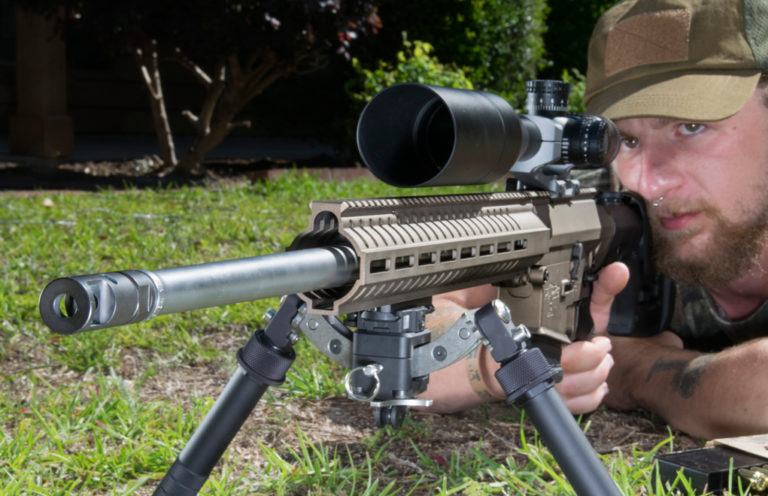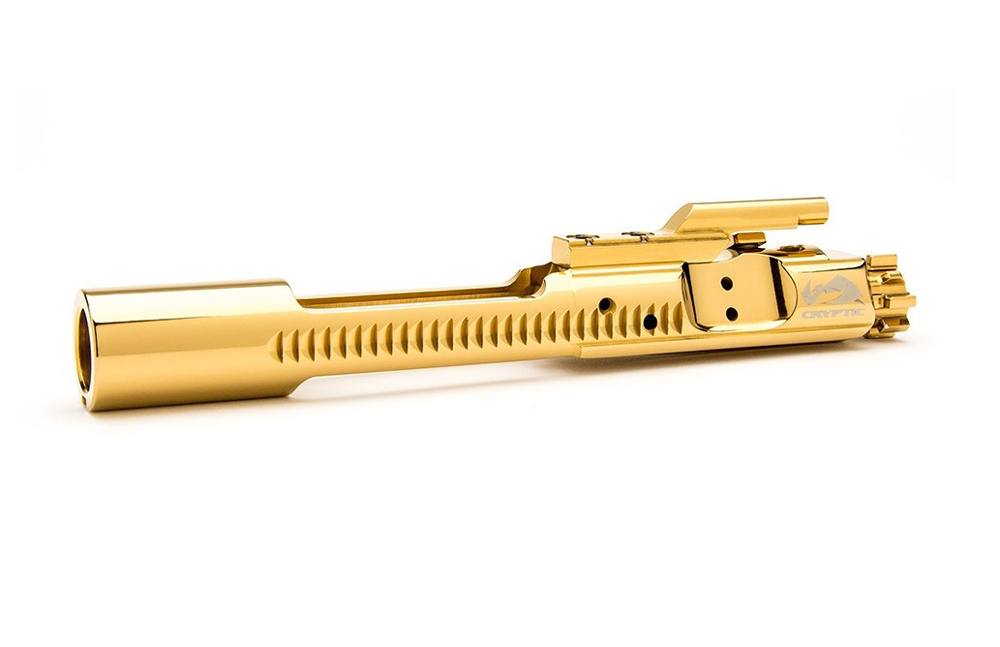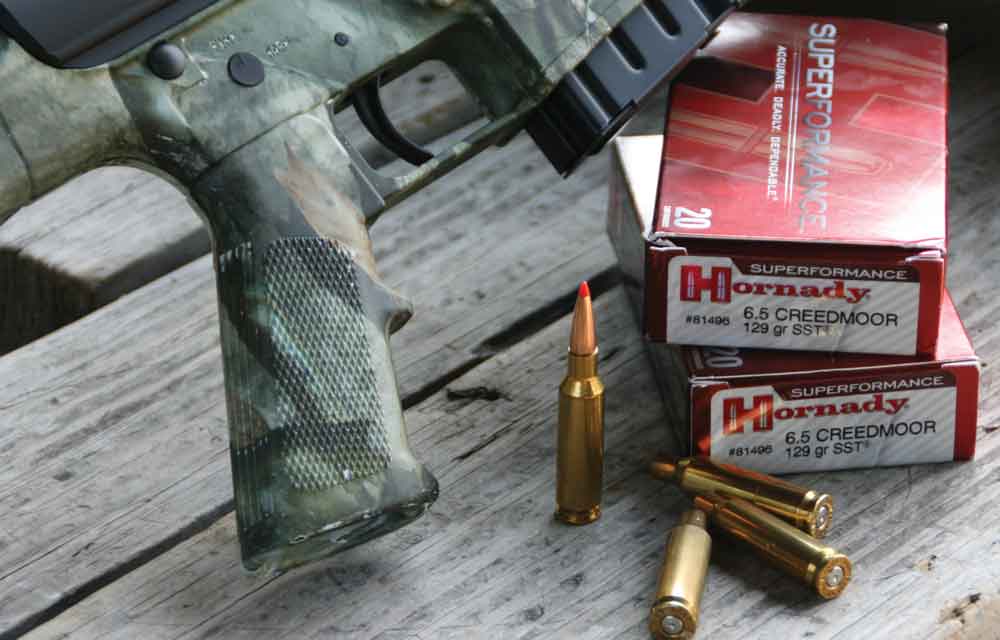
Mastering the particulars of the AR-10 upper receiver helps you get more out of the heavy metal brute.
What you need to know about the AR-10 upper:
- Two main patterns: DPMS and ArmaLite.
- DPMS has a rounded rear cut.
- ArmaLite has an angular rear cut.
- DPMS barrel nut thread pattern is 1-7/16” and 16 TPI-2A.
- ArmaLite barrel nut thread pattern is 1-7/16” and 18 TPI-3A.
- Barrels, barrel extensions, bolt carrier group and firing pin should all be of the same pattern.
- These components can be used in another pattern's upper receiver.
It’s an old song and dance — AR rifles are as versatile as the day is long. Nearly any conceivable long-gun application falls into its wheelhouse, from home defense to long-range shooting, and nailing mid-range targets in between. If you can think of an objective, you can configure your rifle to excel at it.

For the most part, the modularity of the AR system gives the firearm its unique flexibility. And thanks to the military wing of the family — M-16 and M4 Carbine — there’s no shortage of upgrades, accessories and ways to build a rifle. That is if you’re talking about the AR-15.
Standardized, the rifle is nearly limitless in compatible parts that make it shoot faster, more accurately and with greater effect. Not quite so with its bigger (and older) brother, the AR-10.
Having been adopted by a few militaries over the years, the larger-caliber platform doesn’t enjoy the AR-15’s universalism. Nearly 99.9-percent of all Mil-Spec parts from different manufacturers will work with each other in Eugene Stoner’s gas-impingement masterpiece, the AR-15. Not so with the much more atomized world of the AR-10.

Here, designs are freewheeling and proudly idiosyncratic. Far from relegating the AR-10 to one-trick-pony status, its more specific nature simply means more forethought and consideration when buying, building, upgrading and maintaining one. And this holds no more true than where all the action happens on the rifle.
Understanding The AR-10 Upper Receiver
Like Kleenex is to facial tissue, AR-10 is to rifles. It is a specific trademarked designation that over the years has become slang to describe an entire class. Properly used, AR-10 specifically means a particular rifle — the original one designed by Eugen Stoner and still in production today by ArmaLite. There are riffs off the design, a lot of them, but properly defined they are not AR-10s. Their specs are different and they don’t play nice with other patterns of the rifle. To maintain sanity, we’ll only focus on the two most common you’ll encounter the gun store: the original AR-10 still made by ArmaLite and DPMS or LR-308.
In the AR-10 (used in the generic context here on out), the receivers are the defining aspect of the different patterns. As pointed out in a previous post concerning AR-10 lower receivers, the dividing line is their geometry. Simply put, the DPMS has an elliptical rear cut, while ArmaLite has an angular.
AR-10 Essentials: Hit the Bullseye Every Time
- Budget AR-10 Buying Guide
- AR-10 Lower Receiver Breakdown
- AR-10 Development
- Understanding the Components of AR-10 Upper
- Steps To Build an AR-10 – Assembly Guide
Cut to fit these particular shapes, the different AR-10 upper receivers are incompatible with another pattern’s lower. They’re meant to mingle with their own kind. Yes, you can shimmy an ArmaLite upper on to a DPMS lower (the inverse is not true) and get a functional rifle. However, due to gaps between the receivers, this is potentially a dangerous firearm, especially if you experience a ruptured case. A side note, this exclusivity extends to the barrel nut as well, given ArmaLite’s thread pattern is 1-7/16” and 18 TPI-3A, and DPMS 1-7/16” and 16 TPI-2A.

Nuanced and adding complexity to the already complex AR-10 story, the real issues with compatibility in the upper isn’t so much the receiver itself. The main components are the concern. Here we’re talking barrels, barrel extensions, bolt carrier groups and firing pins.
While there is no end of online chatter among home gunsmiths claiming to have mixed and matched these parts, it’s an inadvisable practice. You are dealing with tight tolerances concerning headspace, where a sour experiment can result in — at best — a ruined rifle. In the case of the firing pin, for example, an Armalite pattern in a DPMS bolt can become stuck, setting up the undesirable and dangerous possibility of the bolt closing firing a cartridge – the dreaded “slam fire.”
The safe rule of thumb when dealing with these components is to pick a pattern and stick with it all the way through. You buy an ArmaLite barrel for a build, plan on going ArmaLite on the rest of the parts. Upgrading a DPMS pattern rifle’s bolt, better plan on making sure your choice is compatible. There is some wiggle room here, mainly in context to the receiver they’ll go into. As long as the parts are uniform in pattern, they can go in the other pattern’s upper receiver.

Thankfully, regardless of pattern, quality barrels abound for both ArmaLite and DPMS. Given it is the most common pattern when it comes to anything AR-10, the advantage goes to the latter. There are just more choices when it comes the DPMS, not just with barrels, but across the board. Not that you lose by choosing ArmaLite, but it comes with a real sticky point when shopping for a compatible BCG.
Payoff – AR-10 Calibers
The Gordian knot that is the AR-10 almost doesn’t seem worth untying. Until you cut through to the rifle’s payoff – firepower and caliber versatility.
While the AR-15 chambering choices have grown over the years, they still pale in comparison to its bigger brother. Especially in the power department. Originally chambered for the .308 Win./7.62x51mm NATO, AR-10 calibers have grown to included cartridges as new as the 6.5 Creedmoor and as old as the .45-70 Govt. In general, especially concerning the popular patterns, mainly the short-action rounds have been the focus — .243 Win., .260 Rem., 7mm-08. Though, as insinuated with the .45-70 example, AR-10 calibers know no bounds, as long as you’re willing to go proprietary.

This feature of the gun, arguably, make it potentially more versatile than its little brother — at least in medium- to long-ranges. The AR-10 excels in competition, tact applications, hunting and nearly anything that requires more velocity and energy than an intermediate cartridge provides.
Parting Shot
Yup, the minutia of the AR-10 is about as clear as mud. For some, obviously, this is more than they want or are willing to chew through. There are obvious reasons why the D.I.Y. rifleman has a love affair with the Mil-Spec AR-15. Yet, there is an allure to decoding the AR-10. It might not be as simple a nut to crack as its little brother, but for those willing to put in the work the payoff is potentially greater.

Next Step: Get your FREE Printable Target Pack
Enhance your shooting precision with our 62 MOA Targets, perfect for rifles and handguns. Crafted in collaboration with Storm Tactical for accuracy and versatility.
Subscribe to the Gun Digest email newsletter and get your downloadable target pack sent straight to your inbox. Stay updated with the latest firearms info in the industry.

![Best Concealed Carry Guns In 2025 [Field Tested] Wilson Combat EDC X9S 1](https://gundigest.com/wp-content/uploads/Wilson-Combat-EDC-X9S-1-324x160.jpg)


![Best 9mm Carbine: Affordable PCCs [Tested] Ruger Carbine Shooting](https://gundigest.com/wp-content/uploads/Ruger-Carbine-Shooting-100x70.jpg)
![Best AR-15: Top Options Available Today [Field Tested] Harrington and Richardson PSA XM177E2 feature](https://gundigest.com/wp-content/uploads/Harrington-and-Richardson-PSA-XM177E2-feature-100x70.jpg)

Elwood,
A picture showing the two different cuts- elliptical and angular, would have greatly improved your article. A picture of some jackass shooting an AR is worthless.
Totally agree, but they are pretty obvious when you look at either the upper or lower receiver. One has a curved rear, much like an AR15, and the Armalite (True AR10) has almost a 45 degree flat rear where the BCG slides in. While the DPMS AR.308 may be more common, the true AR10 is not uncommon, and having owned several of both I much prefer the Armalite pattern. FWIW, Knights Armament uses the Armalite pattern, but so does Diamondback. Both ends of the spectrum on price point. I haven’t weighted the bare DPMS style receivers, but the Armalite style feel thicker and more robust to me. Also, I believe the Wilson Combat large format receivers are a third proprietary style. At least they claim as much on their website.